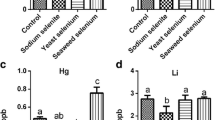Abstract
Protective effects of antioxidant additives of selenium and vitamin E on rats that consumed maize naturally contaminated with mycotoxins were explored in this paper. Thirty-two Wistar female rats were randomly divided into four groups. The control group was given the basic diet with normal maize. The contaminated maize group was given the diet in which normal maize was replaced by mycotoxin-contaminated maize. The selenium group and vitamin E group were respectively fed mycotoxincontaminated diet supplemented with 0.4mg · kg−1 selenium from yeast or 100 mg · kg−1 vitamin E. The trial lasted for 4 weeks. Compared with the control group, antioxidative status was decreased significantly in the contaminated maize group. However, the status in the selenium group and vitamin E group was increased significantly compared with the contaminated maize group. The activities of enzymes related to liver function were significantly higher in the contaminated maize group than those in the control group, whereas they were significantly lower in the selenium group and/or the vitamin E group compared to the contaminated maize group. It is concluded that selenium and vitamin E were able to alleviate oxidative stress and liver function damage due to the consumption of maize naturally contaminated with mycotoxins.
Similar content being viewed by others
References
AOAC (1995). Official Methods of Analysis. 15th ed. Washington D C: Association of Official Analytical Chemists
Curran R D, Ferrari F K, Kispert P H, Stadler J, Stuehr D J, Simmons R L, Billiar T R (1991). Nitric oxide and nitric oxide-generating compounds inhibit hepatocyte protein synthesis. FASEB J, 5: 2085–2092
Dänicke S, Ueberschär K H, Halle I, Matthes S, Valenta H, Flachowsky G (2002). Effect of addition of a detoxifying agent to laying hen diets containing uncontaminated or Fusarium toxin-contaminated maize on performance of hens and on carryover of zearalenone. Poult Sci, 81: 1671–1680
Galvano F, Ritieni A, Piva G, Pietri A (2005). Mycotoxins in the human food chain. In: Diaz D E, ed. The Mycotoxin Blue Book. Nottingham: Nottingham University Press, 187–224
Gautier J C, Holzhaeuser D, Markovic J, Gremaud E, Schilter B, Turesky R J (2001). Oxidative damage and stress response from ochratoxin A exposure in rats. Free Rad Bio Med, 30: 1089–1098
Harbrechet B G, Billiar T R, Stadler J, Demetris A J, Ochoa J B, Curran R D, Simmons R L (1992). Nitric oxide synthesis serves to reduce hepatic damage during acute murine endotoxemia. Crit Care Med, 20: 1568–1574
Hussein H S, Brasel J M (2001). Toxicity, metabolism, and impact of mycotoxins on humans and animals. Toxicol, 167(2): 101–134
Meki A M A, Hussein A A A (2001). Melatonin reduces oxidative stress induced by ochratoxin A in rat liver and kidney. Compara Biochem Physiol Part C: Toxicol & Pharmacol, 130(3): 305–313
Reeves P G, Nielsen F H, FaheyJr G C (1993). AIN-93 purified diets for laboratory rodents: Final report of the American Institute of Nutrition Ad Hoc Writing Committee on the reformulation of the AIN-76A rodent diet. J Nutr, 123: 1939–1951
Rotter B A, Thompson B K, Lessard M, Trenholm H L, Tryphonas H (1994). Influence of low-level exposure to Fusarium mycotoxins on selected immunological and hematological parameters in young swine. Fundam Appl Toxicol, 23: 117–124
Su J, Chen D, Yu B, Wang X, Miao C, Ao Z (2006). Effects of feeding diets naturally contaminated with Fusarium mycotoxins on performance, utilization of nutrients in weaning piglets and the protection of etherified glucomannan mycotoxin adsorbent. Chinese J Anim Sci, 42(19): 26–29 (in Chinese)
Surai P F (2006). Selenium in Nutrition and Health. Nottingham: Nottingham University Press, 28–51
Surai P F, Dvorska J E (2005). Effects of mycotoxins on antioxidant status and immunity. In: Diaz D E, ed. The Mycotoxin Blue Book. Nottingham: Nottingham University Press, 93–137
Swamy H V L N, Smith T K, Karrow N A, Boermans H J (2004). Effects of feeding blends of grains naturally contaminated with Fusarium mycotoxins on growth and immunological parameters of broiler chickens. Poult Sci, 83: 533–543
Swamy H V L N, Smith T K, MacDonald E J, Karrow N A, Woodward B, Boermans H J (2003). Effects of feeding a blend of grains naturally contaminated with Fusarium mycotoxins on growth and immunological measurements of starter pigs, and the efficacy of a polymeric glucomannan mycotoxin adsorbents. J Anim Sci, 81: 2792–2803
Vila B, Jaradat Z W, Marquardt R R (2002). Effect of T-2 toxin on in vivo lipid peroxidation and vitamin E status in mice. Food Chem Toxicol, 40: 479–486
Zhong C, Sun A (1997). Biomedicine of Nitric Oxide. Shanghai: Shanghai Medical University Press, 102–112 (in Chinese)
Author information
Authors and Affiliations
Corresponding author
About this article
Cite this article
Yu, J., Chen, D. & Yu, B. Protective effects of selenium and vitamin E on rats consuming maize naturally contaminated with mycotoxins. Front. Agric. China 3, 95–99 (2009). https://doi.org/10.1007/s11703-009-0015-0
Received:
Accepted:
Published:
Issue Date:
DOI: https://doi.org/10.1007/s11703-009-0015-0




